

The 10: Don Prudhomme
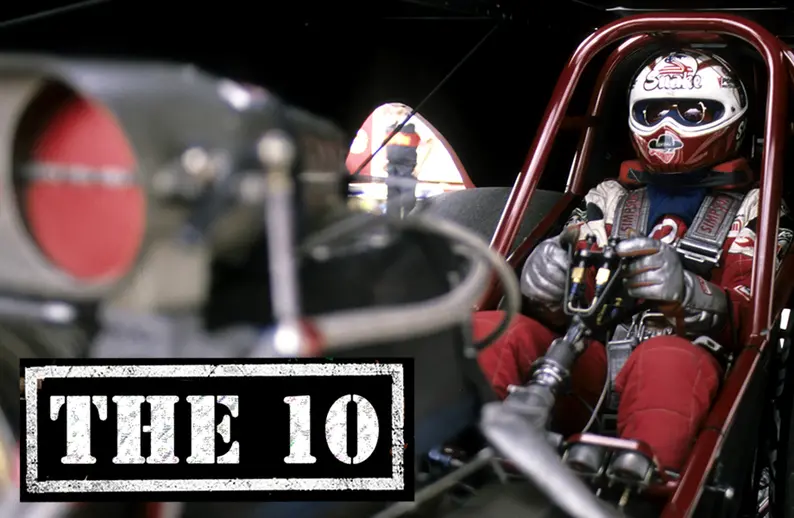
Last week I compared some of the great individual seasons in NHRA’s recent history with the 1976 season of Don “the Snake” Prudhomme, which makes it a perfect time to present the second edition of my The Ten series, which focuses on the 10 greatest moments of some of our heroes’ careers.
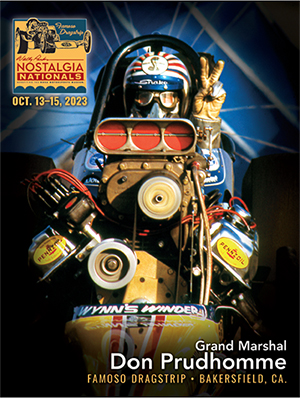
The first installment, presented earlier this year, was on the sport’s other great Don, “Big Daddy” Don Garlits, on the occasion of him being the grand marshal of Wally Parks NHRA Nostalgia Nationals at Beech Bend Raceway Park, and because Prudhomme was the grand marshal at the year’s second WPNN, in Bakersfield, it all seems like a good idea to roll on “the Snake’s” Top 10.
Prudhomme hit the big time in 1965 with car owner and lifelong friend Roland Leong, who hired Prudhomme to drive his Hawaiian Top Fueler. They won the Winternationals and the U.S. Nationals that year, the first two of Prudhomme’s 49 career wins as a driver and of more than 100 that he earned as a driver and car owner.
After scoring five Top Fuel wins, including three at the prestigious U.S. Nationals, Prudhomme and rival-turned-teammate Tom “the Mongoose” McEwen signed a breakthrough sponsorship agreement with Mattel’s Hot Wheels brand and switched to Funny Car in the early 1970s, where his star only continued to shine brighter. Prudhomme would win four straight Funny Car world championships, 1975-78, and lose only one race in the entire 1976 season. After collecting 35 wins in Funny Car, Prudhomme returned to his Top Fuel roots in 1990 and won an additional nine events before retiring at the end of the 1994 season.
Prudhomme went on to become a team owner and boosted the careers of drivers like Larry Dixon and Ron Capps, with whom “the Snake” continued to collect event and world championships until he completely retired from the sport after the 2009 season. He was named No. 3 on the list of NHRA’s Top 50 Racers in 2000.
1962-64: Early stardom with Greer-Black-Prudhomme
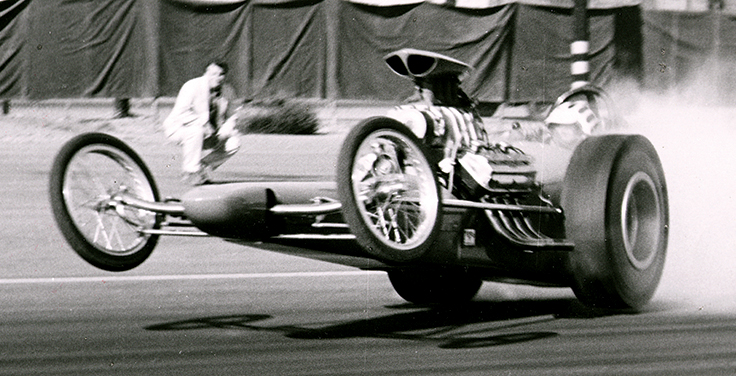
Once a painter at his father’s auto-body business, he fell into league with a group of racers in Southern California’s San Fernando Valley as a member of the fabled Burbank Road Kings car club and progressed through a series of dragsters.
Although Don Prudhomme’s first dragster runs were made in an injected Buick-powered rail he bought from early mentor Tommy Ivo that he later supercharged with help from Dave Zeuschel, Prudhomme quickly gained his first real notoriety as someone to be reckoned with behind the wheel of a dragster owned and financed by Tommy Greer and tuned by engine maestro Keith Black.
The vaunted Greer-Black-Prudhomme dragster was the terror of the Southern California Top Fuel wars from its victory in its June 1962 debut at Pomona Raceway through the end of the 1964 season. While a famous Schiefer Clutch advertisement claimed that Prudhomme racked up a stunning 236-7 win-loss record in that time, the real number is closer to 81-8, still an impressive number, and any time that they lost, it was big news. Black’s deft hand on the engine and clutch developed a combination that, unlike many of the cars of the era, did not smoke the tires the length of the quarter-mile and was thus more consistent and tunable.
It was also during this brief time that Prudhomme acquired “the Snake” nickname from crewmember Joel Purcell, who noted his driver’s lean physique and his deadly starting-line reactions. Prudhomme admits that he hated the nickname at first, but he quickly began to understand its promotional value, and as his skill and confidence grew, he began to realize that he could make a living as a professional race-car driver.
1965: First national event victory

Don Prudhomme first met Roland Leong when the Greer-Black-Prudhomme dragster visited Hawaii for a match race in 1963. Leong had a successful dragster of his own and had dreams of nitro racing on the mainland. He got a Top Fuel car built with a Keith Black engine but crashed on his maiden pass at Lions Dragstrip in the fall of 1964.
About this same time, Tommy Greer had sold his portion of the Greer-Black-Prudhomme dragster to Black, who didn’t have any desire to finance it out of his own pocket, as his deal was building and tuning engines, but he suggested to Leong that Prudhomme, now without a ride, should drive Leong’s Hawaiian dragster. Prudhomme was just two months shy of his 24th birthday and Leong just 20 years old when they debuted at the 1965 Winternationals, a race that Leong had won the year before with future IndyCar star Danny Ongais at the wheel of his gas-powered dragster.
With Black tuning, the Hawaiian won the meet and then a few months later won the Nationals in Indianapolis, the sport’s biggest event. Although they parted company in 1966, they remained friends, and Leong was there for many of Prudhomme’s future Top Fuel successes, and they remain close friends to this day.
1970: The Hot Wheels deal
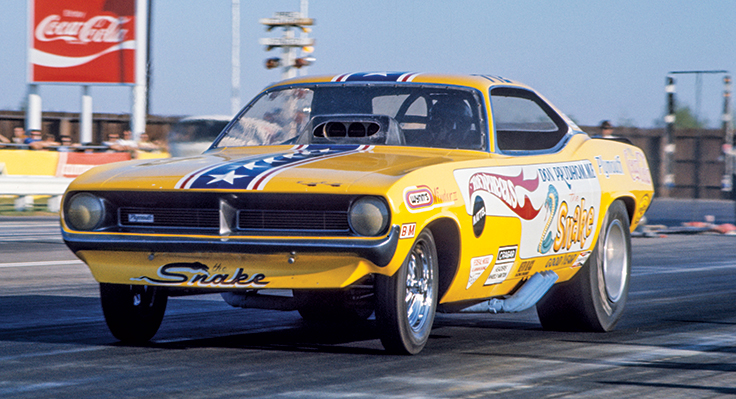
When media-savvy Tom McEwen countered Don Prudhomme’s “Snake” nickname by taking on, at the suggestion of engine builder Ed Donovan, “the Mongoose” sobriquet after an animal known for its ability to kill deadly snakes, he launched an amazing trajectory for the duo that would take their friendly-yet-serious rivalry to new heights.
Always on the lookout for new partners with deep pockets, McEwen was aware of the Mattel toy company’s growingly popular line of diecast Hot Wheels cars, and because McEwen’s mother, Sybil, worked as a secretary at Mattel, and his stepfather, Joe Ball, was an attorney whose clients included Mattel, he was able to get a meeting with Mattel Vice President Art Spear.
Prudhomme remembers being skeptical of the whole idea but went to the meeting, and before long they were in the toy business. Prudhomme admittedly was not a big fan of the still-new Funny Car class, but because Mattel sold toy cars rather than dragsters, that was part of the deal. Before long, kids across the country were staging their own “Snake” versus “Mongoose” battles on their orange plastic dragstrips spread across living rooms everywhere, and the duo became household names and were booked for match races all across the country.
The sponsorship was not the first by a non-racing company (McEwen himself had previously had sponsorships from both a breath spray and an “activity booster”), but it was the largest, richest, and most comprehensive marketing plan ever seen in the sport and opened the doors for countless others to follow.
1973: First Funny Car win
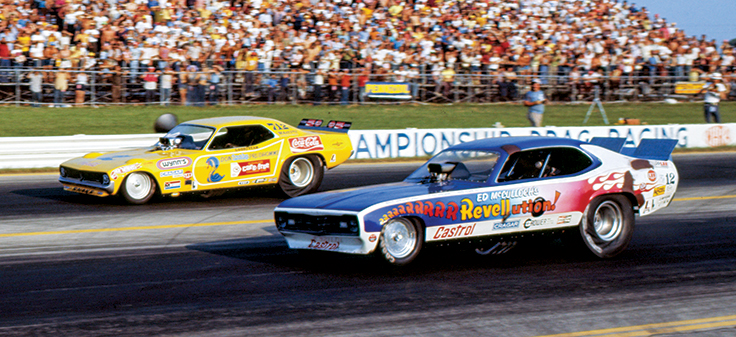
To many people, Don Prudhomme is one of the greatest Funny Car drivers of all time, but “the Snake” really loved his front-engined Top Fuelers and for the first few years in the 1970s ran the Hot Wheels Funny Car only sparingly at NHRA national events and not with much success.
He ran the Funny Car mostly on the match-race trail, where he and Tom McEwen held events at local malls to help spread the Hot Wheels gospel. That all changed when innovative chassis builder John Buttera offered to build him a new Barracuda for the 1973 season, and suddenly “the Snake” had a killer Funny Car.
With Carefree Sugarless Gum taking the main sponsorship over from Hot Wheels on the car, the change was immediate and obvious beyond the livery. The car made its national event debut in June, where he was the No. 1 qualifier at the Springnationals, the Summernationals, and again at the U.S. Nationals, where he raced past Tom Prock, Richard Tharp, and Leroy Goldstein to face off with two-time defending champ Ed McCulloch, whom he beat, 6.38 to 6.34 to become the first driver to have wins in both Top Fuel and Funny Car and would repeat his Indy glory in 1974. Prudhomme would earn 35 of his 49 wins in Funny Car.
1975: First five-second and 240-mph runs

Don Prudhomme had begun the 1975 season in Pomona behind the wheel of what would become one of the most successful and iconic Funny Cars of the era, a red, white, and blue-adorned Chevrolet Monza bearing the colors of “the Snake’s” new sponsor: the U.S. Army.
By the time the season came to its conclusion with a return to Southern California for the NHRA World Finals at Ontario Motor Speedway, Prudhomme had already locked up his first of what would be four straight NHRA Funny Car championships on the strength of five wins at the season’s first seven events, then made it six for eight with a dominating performance in Ontario, Calif.
His 6.15 No. 1 qualifying performance came with the class’ first 240-mph speed (241.53) but gave no hint that he would later run almost two-tenths quicker, and his 6.32 first-round conquest of Al Hanna reinforced that. But “the Snake” and crew chief Bob Brandt hit their stride in round two with a 6.17, then dropped a bomb on archrival Raymond Beadle with a stunning 5.98 in the semifinals.
Prudhomme was not able to back up the five for a national record (that would not happen until Indy the next year), but his final-round 6.15 was more than enough to defeat Denny Savage’s tire-smoking 6.91 in the Chi-Town Hustler in that iconic team’s first national event final-round appearance.
1976: The almost perfect season

After he won six of eight NHRA national events and his first Funny Car championship in 1975, no one could have dreamed that Don Prudhomme would better those numbers in 1976, but he did, bagging seven of eight victories.
Prudhomme, Bob Brandt, and the Army Monza began the season with a huge win at the Winternationals — his third of four straight at the annual season opener — where he also reset the national record en route to capturing his 15th victory, which tied him atop NHRA’s all-time winner’s list with Ronnie Sox. The tie didn’t last long as, in quick succession, “the Snake” struck at the Gatornationals, Springnationals, Summernationals, and Le Grandnational.
Between all the winning there also was loss, as Prudhomme’s older brother, Monette, passed away suddenly of a heart issue in April, and “the Snake” grieved the great loss and even had a health scare of his own not long after — he technically died on the doctor’s table during a preventive heart examination procedure but was quickly revived — but found solace in his return to competition.
Prudhomme’s astounding winning streak ended at 30 rounds in the final of the U.S. Nationals, where he was denied by Gary Burgin. Prudhomme wasted no time recovering from the loss, winning at the Fallnationals and then closed the season at the World Finals in Ontario, Calif., with another dominating performance to capture his seventh win of the season with a 6.09. He won the championship over Burgin by the equivalent of more than 30 rounds of racing.
1975-78: Four straight championships
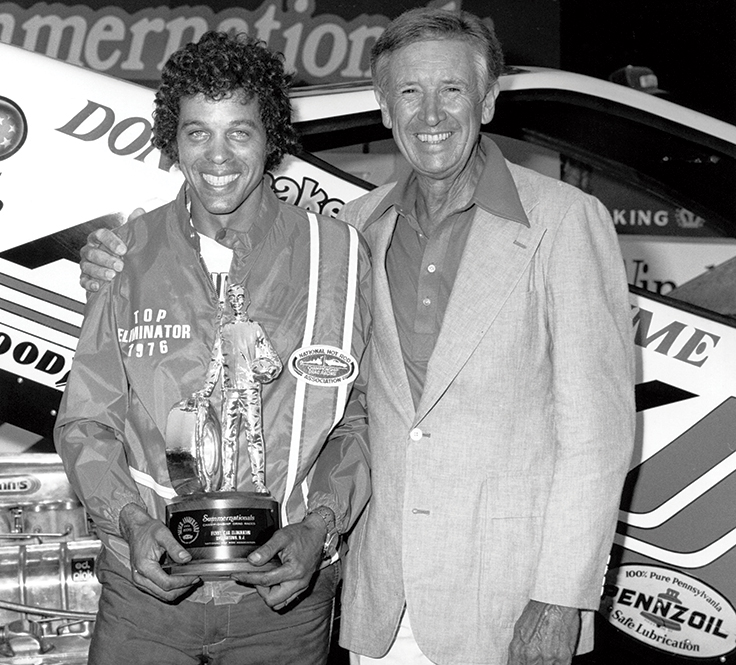
After two dominating seasons in 1975 and ’76 in which he won a combined 13 of 16 national events and his first two championships, Don Prudhomme and Bob Brandt didn’t stop there.
Even though they retired the iconic Monza in favor of a new Plymouth Arrow as part of a new sponsorship and a return to the carmaker with which he started his Funny Car career, Prudhomme would capture championships again in 1977 and ’78. Although he would win just three times in each of those two seasons — a far cry from his two previous championships — in the face of growing performance and confidence from guys like Raymond Beadle, who would win his first of three straight championships in 1979 to end Prudhomme’s reign, Gordie Bonin, Billy Meyer, Dale Pulde, and others, the going was a lot tougher.
After winning the U.S. Nationals again in 1977, in what was his fifth of six straight Indy final-round appearances, the ghosts of 1975 and ’76 returned in 1978, where he again reached the U.S. Nationals final but lost again, this time to archrival Tom McEwen in one of the most memorable moments in event history as McEwen was mourning the loss of his teenage son Jamie, who also was close friends with Prudhomme. In his four-year championship reign, Prudhomme won 19 of the 35 events contested on the NHRA national event tour.
1982: Backbreaking performances return

The 1980s ushered in new levels of engine technology from fuel pumps to ignition systems, and Don Prudhomme and Bob Brandt worked hard to remain on the cutting edge, but by the start of the 1982 season, the wins were fewer and further between as they racked up just six wins in the three years after their championship reign ended.
In 1982, Prudhomme partnered with Pontiac on a sleek new Firebird body and sponsorship by Pepsi in a bid to return to his championship form. Before long, the team hit on a new combination built around a new style of vane fuel pump, and suddenly “the Snake” was back. At the Cajun Nationals in Baton Rouge, La., the Pepsi Challenger became the first Funny Car to exceed 250 mph.
A few months later at the U.S. Nationals, Prudhomme stunned the class and the racing world with a monstrous 5.63-second pass. The national record entering the 1982 season was 5.89, set by Dale Armstrong at the 1981 World Finals, and no one had even run in the 5.70s until Indy when Tom Anderson booted Jim Wemett’s entry to a 5.799, the class’ first 5.7-second pass. The glory did not last long:
Less than a half-hour later, Prudhomme stormed to a 5.73 at just 223.22 mph as the engine blew 100 feet before the first light. In Saturday’s second qualifying session, Prudhomme made a full pull and took away everyone’s breath with the 5.637, a run that was nearly two-tenths of a second quicker than the incoming best and a run that would have qualified fifth in the Top Fuel field.
1990-94: Return to Top Fuel and a Final Strike

After decades on the road, Don Prudhomme knew that his time behind the wheel was coming to an end and decided that his swan song would be a return to the Top Fuel class where it all began. He finished up his Funny Car career with a bang in 1989, scoring three wins, including his seventh and final U.S. Nationals score, then moved to Top Fuel in 1990.
The first year was tough, including two blowover wheelstand crashes, but he won three times in both 1991 and 1992 then, after a winless 1993, declared that 1994 would be his final go-round, called The Final Strike tour. Fans flocked to the races to see the legend’s last season, and he was honored all along the way, often with gifts presented to him by the track operators at each event. He won three more times that season to boost his career total to 49 and battled hard for a storybook world championship conclusion, but he came up just short, finishing second behind Scott Kalitta.
When he retired from driving, Prudhomme held a slew of NHRA records, including longest winning streak, most consecutive victories, most consecutive round-wins, most consecutive final rounds, and most consecutive No. 1 qualifying positions.
1995-2009: Team ownership
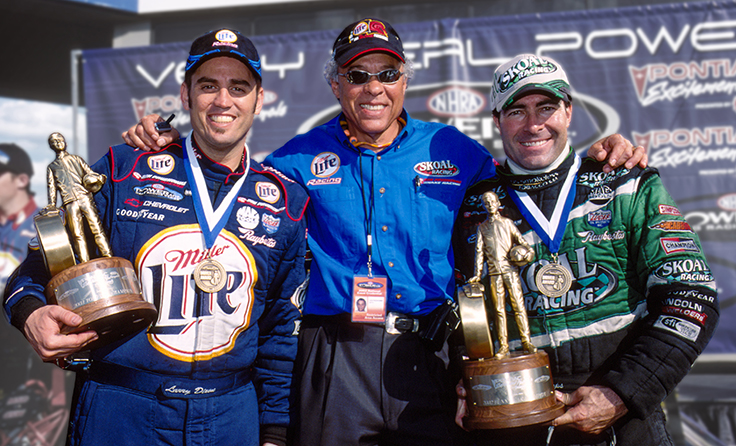
Although one chapter — the driving one — had closed, Don Prudhomme entered a new phase as team owner and boosted the careers of a number of drivers.
Larry Dixon Jr., a longtime crewmember on his cars, took over the wheel of his Top Fueler between 1995 and 2008 and won “the Snake” 43 more Wallys – including three more in Indy – and world championships in 2002 and ’03. In 1997, Prudhomme hired a relatively unknown Top Fuel driver, Ron Capps, who had just one win to his credit on a part-time schedule and had never driven a Funny Car, to launch “the Snake’s” return to Funny Car and added a second Funny Car in 2001 with Tommy Johnson Jr. driving. Capps added 16 more wins to Prudhomme’s total during his 1997-2005 tenure, while Johnson added another two wins in his six-year run at Snake Racing.
On four occasions during the multicar team years — three times with Dixon and Capps and once with Dixon and Johnson — Prudhomme’s drivers swept the Top Fuel and Funny Car titles at the same event. Spencer Massey replaced Dixon in the Top Fueler for the 2009 season and racked up two wins to push Prudhomme’s final total to 112 event victories — including 10 U.S. Nationals crowns — and six world championships.
So there you have it, 10 defining moments from one of the sport's all-time greats. I'll continue this series in 2024, and would be interested to hear which drivers you'd like to see profiled in this way. Thanks, as always for following along. It's been another great year of columns and one that I'm happen to still be able to write on this one-year anniversary of The Big Scare. Stay well, friends.
Phil Burgess can be reached at pburgess@nhra.com
Hundreds of more articles like this can be found in the DRAGSTER INSIDER COLUMN ARCHIVE
Or try the Random Dragster Insider story generator



















































